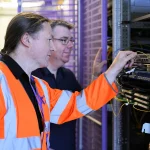3,835 UK Schools are in Postcodes with No Access to Full Fibre

New data from the UK Government’s Department for Digital, Culture, Media and Sport (DCMS) and Schools Minister, Robin Walker, has revealed that 3,835 schools are in postcodes “that do not have access” to full fibre broadband connectivity “or are currently not in areas of proposed commercial build within the next five years“.
The Government’s Building Digital UK team and related £5bn Project Gigabit programme revealed last month that 1,084 schools in rural areas have been connected to a gigabit-capable “full fibre” network – costing £27.6m – as a result of the public investment they started in 2019 (here). A further 884 schools are also planned to be connected by March 2022 (costing £22.5m), but clearly a big gap will still remain.
Admittedly, the DCMS figures have NOT factored in other forms of gigabit-capable connectivity, such as via Virgin Media’s DOCSIS 3.1 capable Hybrid Fibre Coax (HFC) network or leased lines. Some schools do make use of such methods, although these are admittedly much more common in urban environments.
Advertisement
A Government Spokesperson said (Schools Week):
“[We want] all schools in the country to have access to fast internet. We are committed to continued investment, ensuring that every school has access to modern internet connectivity in the classroom – benefiting thousands more children and teachers.
We are working to accelerate connectivity to schools and the Government’s Gigabit Hubs programme will provide fast internet to around 2,000 schools. Separately, we are investing up to £30 million in a pilot to upgrade schools’ digital infrastructure in around 1,000 schools, allowing them to benefit from fast Wi-Fi and cloud services.”
However, the Shadow Schools Minister, Peter Kyle, attacked the government’s “lack of ambition for children is shining through again, leaving nearly 4,000 schools without access to full-fibre in 2025.” The reality is that, short of a leased line, full fibre (FTTP etc.) broadband by itself may need until around 2030 or later to reach virtually every premises across the country. So some Schools may be waiting for longer than 2025.
But as we hinted above, the impact of this may vary as Project Gigabit is technologically neutral, which means that such services don’t strictly have to be delivered via FTTP.
Mark is a professional technology writer, IT consultant and computer engineer from Dorset (England), he also founded ISPreview in 1999 and enjoys analysing the latest telecoms and broadband developments. Find me on X (Twitter), Mastodon, Facebook, BlueSky, Threads.net and Linkedin.
« Quantum Fibre Builds FTTP to First 5,000 Lincolnshire Premises






















































Where as all the schools where B4RN builds have already got a 10gig symmetrical free service. Makes you wonder why an altnet can do it but the incumbent can’t doesn’t it?
Obviously, B4RN is a Community Benefit Society, which is quite effective at extracting both free wayleaves and exchanging community volunteered labour for shares. Neither is particularly comparable with a commercial deployment.
Equally, B4RN’s model doesn’t work everywhere and has not been able to cover every UK school. Like it or not, even with the money in place, FTTP still takes years to build across an entire country. No waving of any magic wands is going to change that.
Is this some kind of troll from B4RN? Are you comparing local project to country wide network?
@Chris
If BT Group started to offer free connectivity to all schools then, given it has significant market power in many places according to Ofcom, it is likely that competitors would complain, especially those focused on the education sector. The Competition Act would no doubt be an issue here.
More generally, it’s worth considering whether broadband is the best connectivity option for most schools. Ethernet generally comes with far superior SLAs and often has throughput guarantees too, at least on-net, plus the potential for diverse routing etc.
… and most of those will remain there indefinaitely …
Shock horror, because you need FTTP to teach schoolkids don’t you otherwise they just grow up to be doctors, engineers and research scientists etc etc.
They grow up to become MP’s otherwise…….
Correction: otherwise they will mutate to become MPs.
FIFY
“that 3,835 schools are in postcodes “that do not have access”
Are we taking off: “A further 884 schools are also planned to be connected by March 2022”
Ignoring (which we shouldn’t really but) “DCMS figures have NOT factored in other forms of gigabit-capable connectivity”
If so that doesn’t seem to add up to:
“lack of ambition for children is shining through again, leaving nearly 4,000 schools without access to full-fibre in 2025.”
most of these will have dedicated ethernet in the school —
Strangely, I’ve had a email from Virgin offering their laughably expensive 1GB service this last week. Router says I’m still on DOCSYS 3.0 though.
Need a Hub 4 or higher to be on 3.1.
I notice that the statement is carefully worded so these schools could have fibre of their own but are mentioned because the rest of the postcode, which may be all theirs, do not.
exactly 100%
All the schools in our LAA have fibre, but as noted this is not the same fibre as availble to the general public, I live in same post code as our small local school, until we had BDUK funded FTTP a couple of years back this school would have shown as being in a area without FTTP. I’m not sure of exact details across whole LAA but it is conceivable that there are still areas around some schools which haven’t yet got FTTP despite the school having it.
In my opinion this a direct result of restricted and unprioritized LFFN funding (in suburban areas in South East) overbuilding existing networks whilst ignoring communities with no Fibre presence at all.
In addition schools should have been a priority or obligation in BDUK contracts. I hope this has been addressed in the BDUK New Procurements.
Schools need funding and government network subsidies need focus.
You know this seems to be tracking regular broadband FTTP while LFFN delivered point to point solutions to nearly everything, right?
LFFN was to connect public sector buildings with a hope that the fibre spine built to accomplish this would be leveraged to deliver broadband services later on.
I look forward to a review of LFFN by the public accounts committee and national audit office. It always seemed to be an expensive waste of money to me, took no account of the presence of non-broadband connectivity to a site.
Schools are businesses. They are multiple user environments, business profile, require business resilience and SLAs. They should be funded accordingly.
LNNF (2016/17) in West Sussex has indeed connected Public Buildings but mainly in the main towns where multiple alternative suppliers already existed (leased line PON).
The promised subsequent broadband development by the successful provider (Cityfibre) has only just started, but again in parts of the large towns. Most of the smaller towns and larger villages (including some that were LNNF connected) are not currently on their plans and many now appear to be encompassed by OR plans (next 2/3 years).
My argument is that if the money had been spent on the smaller towns and larger villages the cost of fibre connectivity for schools and businesses within them would have been reduced and possibly provided earlier. In addition it would have provided greater competitiveness of the upcoming BDUK New Procurements in the surrounding areas.
We are now 4/5 years on from LNNF and not much to show for it for the time/money spent. No doubt some local authority benefits accrued but was the objective.
‘LNNF (2016/17) in West Sussex has indeed connected Public Buildings but mainly in the main towns where multiple alternative suppliers already existed (leased line PON).’
Leased line PON, huh?
‘We are now 4/5 years on from LNNF and not much to show for it for the time/money spent. No doubt some local authority benefits accrued but was the objective.’
LFFN, Local Full Fibre Network, and local authority / public sector benefits were indeed the objective. There have been a few widespread FTTP deployments building on that LFFN rollout and that number will inevitably increase as time goes on.
” 3,835 schools are in postcodes “that do not have access” ”
My “postcode” has access to full-fibre but 90% of the properties in said postcode don’t. Is the DCMS making a dangerous assumption that schools in postcodes with FTTP presence equates to the school also having access to FTTP? That seems a massive over-assumption.
They are making the even more ridiculous assumption that because full fibre broadband isn’t available the schools don’t have their own leased lines.
I can think of a couple of local schools whose postcodes would show no FTTP on Ofcom’s checker. Both have point to point fibre.
I fear the same issue of service by postcode will occur, mine has 80Mbs, but only for half of the road, the other half struggle to get 24Mbs. And we are getting a new DSALM alongside the original, still too far away to improve the service, oh more crosstalk.
We also have extended DSLAM, and the 100Mbs bolton to the pcap, at least 20m away from any potential user.
They really think this through!!
Bolton to the pcap?
re addition (bolton) to the pcap?
Yes its to do with the G-INP service, I asked the engineer. The pcap is a junction for the EO lines.
The cabinets are
PCAP+G-INP, DSLAM(new), DSALM(original)+EXTENSION.
I fully expect the new DSLAM to be extended like the original
Could “ Bolton to the pcap?” Mean “bolt on to the pcp” ??
As in GFast type side pod on PCP but used for FTTC?
@A_Builder says:
Could “ Bolton to the pcap?” Mean “bolt on to the pcp” ??
Yes it is on the PCP, all nice and shiny.
As in GFast type side pod on PCP but used for FTTC?
NO, there is a nice new shiny DSLAM powered from the original DSLAM to ‘improve’ the service.
The shiny bit on the PCP is for Gfast, but is 20m away from the commercial premises.
We didn’t have full fibre at school and it never dented my education .
All these reports are created to point blame
I think that the numbers are a bit suspect as the work done by the 10 Regional Broadband Consortia don’t seem to be factored in. They did a lot of work getting connectivity to schools across England with many via leased lines or other non FTTP methods which will not show up against a simple postcode v gigabit test using OFCOM data. I know that all secondary schools got a minimum of 100Mbs with many getting full fibre links. I guess a sub-set of the primaries ditto. In the case of CLEO I know we put in dark fibre to quite a few schools across Lancashire and Cumbria. So the picture may not be quite as bad as the headlines suggest.
One point worth noting is that schools need symmetrical bandwidth as a lot of video conferencing and virtual classroom work needs high speed upload as well as download. The RBCs put in a lot of work on that establishing 100Mbs upload as a minimum for secondary schools.
One word.
Starlink
Or an alternative… SpaceJunk.
A wholly unsuitable option for lots of people in a school.
Two words.
Not relevant
Yes, this is exactly the high priced premium service us tax payers need to be paying for!
I thought all schools and collages were connected to the JANET network?
A new definition of FTTC – fibre to the collage!? 😉
JANET originally connected higher education and research institutions. They support schools now but a connection to the JANET backbone would still be required.
A lot of schools have a (more suitable) Ethernet service already, rather than FTTP so it isn’t really that useful a data point.
Do any of the current fibre programmes prioritise schools?
If not.. why is this a surprise?
The prospect of any school without at least a Gigabit symmetrical connection in this day and age is preposterous, especially with needs like remote learning.